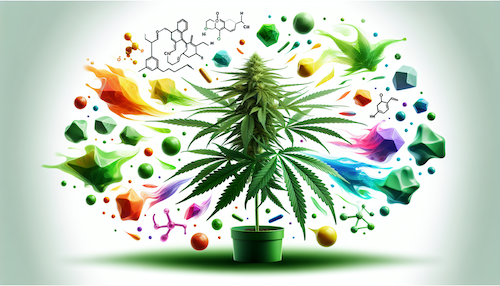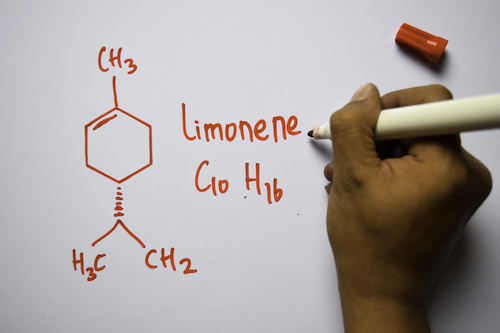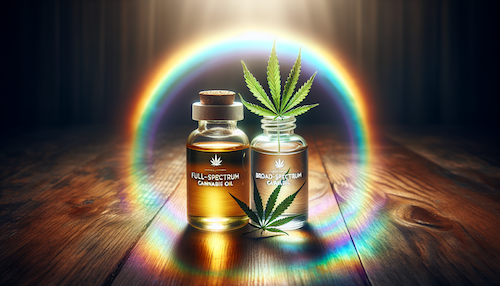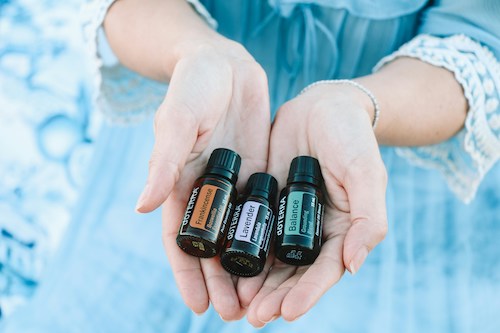Understanding the CBD Entourage Effect and Its Benefits
Written by: Daniel Fayad, Subject Matter Expert and Website President
Published: March 15, 2024; Last updated: April 6, 2024
- 1. Key Takeaways
- 2. Unlocking the Synergy: Defining the CBD Entourage Effect
- 2.1 The Ensemble of Compounds
- 2.2 The Role of Cannabis Sativa
- 3. Investigating the Evidence: Research on the CBD Entourage Effect
- 3.1 Mixed Results and Anecdotal Evidence
- 3.2 The Impact on Treating Anxiety Disorders and Other Conditions
- 4. The Dynamics of Cannabinoids and Terpenes
- 4.1 Interactions with the Central Nervous System
- 4.2 Beyond THC and CBD
- 5. From Theory to Practice: Utilizing the Entourage Effect
- 5.1 Choosing the Right Cannabis Plant Extracts
- 5.2 Full Spectrum vs. Broad Spectrum: Understanding the Difference
- 6. The Entourage Effect in Everyday Life
- 6.1 Managing Expectations: Low Doses and Personal Sensitivity
- 6.2 Incorporating Essential Oils and Aromatic Compounds
- 7. Navigating Legalities and Safety
- 7.1 Compliance with the Controlled Substances Act
- 7.2 Ensuring Product Quality and Purity
- 8. Summary
- 9. Frequently Asked Questions
- 9.1 Does CBD have an entourage effect?
- 9.2 What does the entourage effect feel like?
- 9.3 How do you do the entourage effect?
- 9.4 Does CBD make you feel spacey?
- 9.5 What is the CBD Entourage Effect?
- 9.6 Does CBD come from cannabis plants?
- 10. References
You’re not alone if you’re curious about the entourage effect of CBD. This term refers to the phenomenon where all the compounds of the cannabis plant, including CBD, cannabinoids, terpenes, and flavonoids, interact to enhance the plant’s overall effects potentially. Our exploration will guide you through what this means for using CBD products without the guesswork or the gimmicks.
Key Takeaways
- The CBD Entourage Effect refers to the synergistic interaction of various cannabis compounds, including cannabinoids, terpenes, and flavonoids. It is maximized using full-spectrum CBD products rather than CBD isolate products, which only contain CBD.
- Research on the CBD Entourage Effect is in its early stages, with mixed results and anecdotal evidence showing both support for and against the theory; however, it may have potential therapeutic implications for anxiety, depression, and several psychiatric disorders.
- Legal considerations remain a challenge for the cannabis industry, with stringent regulations like the Controlled Substances Act governing the sale and distribution of CBD products, necessitating compliance to avoid legal penalties and emphasizing the need for high standards of product quality and purity, assured through rigorous testing and accurate labeling.
Unlocking the Synergy: Defining the CBD Entourage Effect

Imagine an orchestra where each instrument plays a role in creating a harmonious symphony. In a similar vein, the cannabis plant contains a multitude of compounds that synergistically interact, giving rise to what we call the CBD Entourage Effect. This synergistic interaction of various compounds, including:
- cannabinoids such as THC and CBD
- terpenes
- flavonoids
- other complementary compounds
The anti-inflammatory effects of the plant enhance its therapeutic potential.
However, not all cannabis products offer this synergistic experience. CBD isolate products, for instance, solely contain CBD, lacking other cannabis compounds that contribute to the entourage effect. Hence, for a complete understanding of the entourage effect, it’s recommended to opt for full-spectrum CBD products, encompassing all active compounds found in the cannabis plant.
The Ensemble of Compounds
The cannabis plant boasts a wealth of compounds, each playing a unique role in the entourage effect. The six primary cannabinoids identified in the cannabis plant, which interact with the cannabinoid receptor, are:
- THC
- CBD
- CBG
- CBN
- CBC
- THCV
Along with their acidic counterparts like tetrahydrocannabinolic acid (THCA) and cannabidiolic acid (CBDA). Each of these compounds has distinct properties that contribute to the entourage effect. ¹
In addition to cannabinoids, terpenes and flavonoids also play a significant role in the entourage effect. Terpenes are aromatic compounds that interact with cannabinoids, thereby enhancing the therapeutic potential of the cannabis plant. Flavonoids, like derivatives of flavone (apigenin and luteolin) and flavonol (kaempferol and quercetin), also contribute by interacting with cannabinoids and terpenes.
The Role of Cannabis Sativa
Cannabis Sativa, a specific species of the cannabis plant, plays a pivotal role in the entourage effect. The diverse range of compounds it houses, like CBD and terpenes, work together to generate distinct effects and advantages. Terpenes, in particular, are commonly known as ‘entourage compounds’ due to their capacity to augment blood-brain barrier permeability and potentially intensify the impacts of other cannabinoids, such as CBD.
When it comes to the entourage effect, the whole is greater than the sum of its parts. The effect of Cannabis Sativa’s myriad of compounds, working in harmony, is more potent than the effect of any single compound. This synergy leads to a heightened, enduring, and pleasurable consumption experience, emphasizing the therapeutic potential of THC and CBD and the entire family of cannabinoids, terpenes, and other compounds found in the plant, including their psychoactive effects.
Investigating the Evidence: Research on the CBD Entourage Effect
Delving into the realm of science, it becomes evident that research into the CBD Entourage Effect is still in its early stages. With varying results and anecdotal evidence currently forming the basis of our understanding, the scientific community is striving hard to unravel the intricacies of this intriguing phenomenon.
Even though the research is limited in scope, existing studies support the validity of the theory and suggest the possibility of beneficial therapeutic effects. For instance, recent studies have shown positive therapeutic outcomes from the combined use of THC and CBD, emphasizing the potential therapeutic benefits of cannabidiolic acid (CBDA).
Mixed Results and Anecdotal Evidence
The science behind the CBD Entourage Effect is a mixed bag, with recent studies pointing towards both supporting and contradictory findings. One in vitro study proposes that the entourage effect may be more speculative than factual. At the same time, another suggests that terpenes do not modify cannabinoid receptors, indicating a lack of synergistic interaction.
However, anecdotal evidence leans towards a more positive narrative. Users frequently report a variety of favorable experiences as a result of the CBD entourage effect, such as:
- Decreased adverse effects from THC
- Sensations of tranquility and stability without any adverse side effects
- Alleviation from conditions such as pain, anxiety, and inflammation
The Impact on Treating Anxiety Disorders and Other Conditions
While the scientific debate continues, the potential therapeutic implications of the CBD Entourage Effect are hard to ignore. Recent research suggests its potential effectiveness in alleviating anxiety, with studies recognizing the anxiolytic properties of CBD and further evidence indicating the antidepressant effects of terpenes when used in conjunction with CBD.
Beyond anxiety, the entourage effect also shows promise in addressing other mental health conditions, such as depression, and its therapeutic potential extends to various psychiatric disorders like epilepsy. However, it’s crucial to remember that using CBD for the treatment of anxiety disorders typically leads to minimal side effects, such as nausea, fatigue, and irritability. It is always recommended to seek advice from a healthcare professional before using CBD, particularly when simultaneously taking other medications, to avoid potential interactions.
The Dynamics of Cannabinoids and Terpenes

Grasping the CBD Entourage Effect necessitates an in-depth understanding of the interactions between cannabinoids and terpenes, the main contributors to this phenomenon. These compounds interact with the central nervous system, playing a crucial role in the entourage effect.
Despite some studies suggesting that terpenes do not have any impact on cannabinoids and the endocannabinoid system, others indicate that terpenes, such as myrcene, may enhance the effects of both THC and CBD. This suggests that the entourage effect goes beyond THC and CBD, involving many other cannabinoids and terpenes for a more comprehensive experience.
Interactions with the Central Nervous System
The endocannabinoid system is modulatory in the brain, endocrine, and immune tissues, regulating hormones associated with reproductive functions and stress responses. It also governs essential functions, including:
- learning
- memory
- emotional processing
- sleep
Cannabinoids such as CBD modulate the activity of cannabinoid receptors and influence the production and breakdown of endocannabinoids within the endocannabinoid system, affecting various bodily functions. Certain compounds like linalool, present in lavender, and myrcene, found in hops, have calming effects that may offer potential benefits in managing anxiety disorders.
Beyond THC and CBD
One might wonder, “Does the entourage effect” rely solely on THC and CBD? The answer is no. Other cannabinoids, like CBG, CBC, CBN, and terpenes, play significant roles in this symphony of compounds. These elements contribute to the entourage effect by altering the binding of other ligands and demonstrating synergy with each other as well as with other secondary metabolites and phytochemicals.
The cannabis plant contains a wide range of terpenes, such as:
- pinene
- limonene
- linalool
- myrcene
- and others
With a total of up to 220 different terpenes. These terpenes contribute to the plant’s distinctive aroma and potential medicinal properties. These terpenes, along with various cannabinoids, work in harmony to create the entourage effect. ¹
From Theory to Practice: Utilizing the Entourage Effect
While comprehending the theory underpinning the CBD Entourage Effect is crucial, the real challenge lies in translating this knowledge into practical use. Utilizing the entourage effect involves choosing the right cannabis extracts and understanding the difference between full-spectrum and broad-spectrum products.
Full-spectrum cannabis extracts encompass all cannabis compounds, including THC, whereas broad-spectrum cannabis extracts exclude THC, providing a customized experience devoid of the psychoactive element. Hence, for a complete understanding of the entourage effect, it’s recommended to opt for full-spectrum CBD products, encompassing all active compounds found in the cannabis plant.
Choosing the Right Cannabis Plant Extracts
There’s a wide variety of cannabis extracts, including:
- Crude Oil
- Live Resin
- Shatter
- Badder
- Sugar
- Wax
- Sauce
- THCa Crystalline
- THC Distillate
- Full Spectrum Oil Concentrates
- Crumble
- Rosin
- Budder
- Kief
- Hash
Each extract has its unique characteristics. However, to optimize the entourage effect, it’s crucial to consider full-spectrum extracts, as they preserve all the supplementary cannabinoids present in cannabis plants.
Total spectrum cannabis extracts:
- Derived from the entire cannabis plant
- Consist of a wide range of cannabinoids, flavonoids, and terpenes
- More potent than pure CBD
- Diverse compounds work together to enhance the entourage effect.
Full Spectrum vs. Broad Spectrum: Understanding the Difference

Full-spectrum and broad-spectrum cannabis extracts both contribute to the entourage effect, but they offer different experiences. Full-spectrum cannabis extracts encompass all cannabis compounds, including THC. On the other hand, broad-spectrum cannabis extracts exclude THC, offering a customized experience devoid of the psychoactive element.
To produce full-spectrum extracts, the entire cannabis plant is soaked in ice water and stirred to remove the trichomes. Broad-spectrum extracts, however, are produced by distilling full-spectrum extracts to remove THC selectively. Therefore, the choice between full-spectrum and broad-spectrum depends on individual preferences and sensitivity to THC.
The Entourage Effect in Everyday Life
Having delved into the science of the CBD Entourage Effect, the next step is to understand how to apply this knowledge in our daily lives. The key lies in managing expectations, starting with low doses of cannabis-based products and understanding personal sensitivity to various cannabinoids.
Essential oils, including Frankincense, Lavender, and Eucalyptus, also have the potential to enhance the CBD entourage effect, promoting comprehensive well-being through the provision of therapeutic aromas that interact harmoniously with cannabinoids.
Managing Expectations: Low Doses and Personal Sensitivity
One of the critical aspects of utilizing the CBD Entourage Effect is understanding personal sensitivity to cannabinoids. Individual sensitivity to CBD and other cannabinoids can significantly impact the response to these compounds. For instance, variations in the effects of THC and CBD on brain function can lead to diverse symptomatic and behavioral responses among different individuals.
Consequently, starting with a mild dose of 20 to 40 mg of CBD per day is recommended, and the dosage should be gradually increased by 5 mg weekly until the desired effects are achieved. Adapting the dosage can help manage potential side effects like:
- drowsiness
- digestive disturbances
- mood variations
- dry mouth
- appetite reduction
- nausea
Incorporating Essential Oils and Aromatic Compounds

Essential oils and aromatic compounds such as terpenes can significantly enhance the CBD Entourage Effect. These compounds synergize with cannabinoids to facilitate:
- relaxation
- stress relief
- energy enhancement
- improved focus
Furthermore, the combination of essential oils with CBD oil has the potential to reduce symptoms of chronic pain, alleviate anxiety, and decrease the occurrence of associated headaches, thereby harnessing the therapeutic properties of both CBD and essential oils to enhance overall wellness.
There are several secure techniques for integrating essential oils and aromatic compounds with CBD usage, such as CBD aromatherapy and consuming CBD with food.
Navigating Legalities and Safety
Navigating the world of cannabis products demands a keen understanding of legalities and safety precautions. CBD products are not considered dietary supplements under the Controlled Substances Act. Moreover, marijuana and THC, which are associated with CBD, are still classified as prohibited substances under Schedule I of the Act.
Potential legal issues stemming from the sale or use of CBD products encompass selling unapproved items with unverified therapeutic assertions and breaching state regulations by vending to underage individuals. Furthermore, it’s crucial to ensure that all CBD products have undergone thorough purity testing and have transparent labeling detailing the CBD content per serving.
Compliance with the Controlled Substances Act
The Controlled Substances Act categorizes marijuana as a Schedule I controlled substance and has regulated components of the Cannabis sativa plant since 1970. Therefore, adherence to this act is crucial while dealing with CBD products.
The sale and distribution of cannabis products are regulated by the Controlled Substances Act (CSA). Cannabis products are considered controlled substances unless they meet the statutory requirements. Failure to adhere to these regulations can lead to criminal liability, particularly for hemp producers producing non-compliant hemp.
Ensuring Product Quality and Purity
Selecting CBD products necessitates a thorough check of their quality and purity. High-quality CBD products undergo laboratory testing to ensure their safety and purity. Therefore, opting for products that have undergone rigorous purity testing and have transparent labeling detailing the CBD content per serving is always recommended.
Third-party lab tests play a crucial role in ascertaining the quality and purity of CBD products. These laboratories furnish impartial and unbiased assessments of each product batch’s precise composition, potency, and overall quality, making a substantial contribution to consumer safety and confidence.
Summary
The CBD Entourage Effect is indeed a fascinating aspect of cannabis science. The synergy between various compounds in the cannabis plant and their interaction with the central nervous system plays a crucial role in the therapeutic potential of cannabis. While the research on the CBD Entourage Effect is still in its nascent stages, anecdotal evidence points towards its potential benefits in treating various conditions, including anxiety disorders.
As we navigate through the world of cannabis and its many intricacies, it’s crucial to understand the legalities and safety considerations associated with the use of cannabis products. Ensuring product quality, purity, and compliance with the Controlled Substances Act are paramount. Remember, the key to harnessing the entourage effect lies in managing expectations, starting with low doses, understanding personal sensitivity, and incorporating essential oils and aromatic compounds. So, let’s embrace this knowledge and unlock the therapeutic potential of cannabis!
Frequently Asked Questions
Does CBD have an entourage effect?
Yes, CBD has an entourage effect when combined with other cannabinoids, terpenes, and hemp compounds, leading to a more significant therapeutic benefit than CBD alone.
What does the entourage effect feel like?
The entourage effect intensifies the cannabis consumption experience, making pain relief or anxiety soothing last longer and feel deeper.
How do you do the entourage effect?
To achieve the entourage effect, consider taking THC and CBD together, as they can be more effective in combination than alone. High doses of THC on their own may cause intoxication.
Does CBD make you feel spacey?
No, CBD doesn’t make you feel spacey. It is not psychoactive and doesn’t produce a ‘high,’ but instead is associated with feelings of calm and relaxation. Some individuals might experience mild drowsiness at high doses, but these effects are generally subtle.
What is the CBD Entourage Effect?
The CBD Entourage Effect refers to the synergistic interaction of compounds in the cannabis plant, enhancing its therapeutic potential, including anti-inflammatory effects. This occurs when multiple compounds in the plant work together rather than in isolation.
Does CBD come from cannabis plants?
Yes, CBD (cannabidiol) is a compound that is naturally derived from cannabis plants. It is one of the many cannabinoids found in cannabis. CBD can be extracted from different varieties of the cannabis plant, including Cannabis sativa, Cannabis indica, and Cannabis ruderalis.
References
Ferber, S. G., Namdar, D., Hen-Shoval, D., Eger, G., Koltai, H., Shoval, G., Shbiro, L., & Weller, A. (2020). The “Entourage Effect”: Terpenes Coupled with Cannabinoids for the Treatment of Mood Disorders and Anxiety Disorders. Current neuropharmacology, 18(2), 87–96. https://doi.org/10.2174/1570159X17666190903103923
Christensen, C., Rose, M., Cornett, C., & Allesø, M. (2023). Decoding the Postulated Entourage Effect of Medicinal Cannabis: What It Is and What It Isn’t. Biomedicines, 11(8), 2323. https://doi.org/10.3390/biomedicines11082323
Handley, E., & here, P. enter your name. (2023, March 6). What is the “entourage effect” of cannabis and how can it relieve pain? Open Access Government. https://www.openaccessgovernment.org/entourage-effect-cannabis-relieve-pain-cannaboids-terpenes/154305/

Written by Daniel Fayad - Subject Matter Expert and Website President
Dan Fayad is a results-driven healthcare administration expert and content writer. With a Master of Health Administration from the University of Southern California, he’s carved a niche for himself in the dynamic world of healthcare and business development. Dan uses his experience to educate and empower people on their wellness journeys.
Join the CBDeals Club!
Get 10% off your first order and receive our best and exclusive promotions directly to your inbox!

